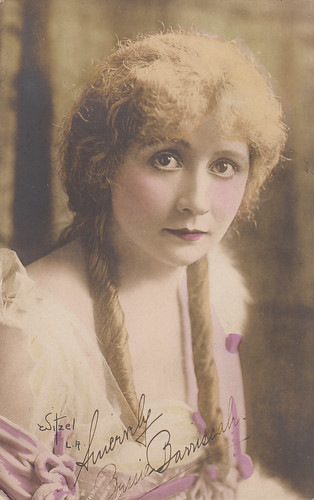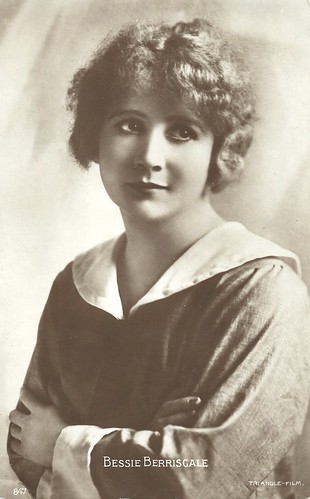
American postcard. Photo: Evans.

Swedish postcard by Förlag Nordisk Konst, Stockholm, no. 846. Photo: Triangle-Film.
A leading lady of David Belasco
Bessie Barriscale was born Elizabeth Barry Scale in 1884 in Hoboken, New Jersey. Her parents were Irish immigrants from County Cork. Her father came to the United States with a London company that presented 'The Lights of London'. The actresses Edith and Mabel Taliaferro were her cousins. At age 5 Bessie debuted on stage with actor and playwright James A. Herne.
As a young woman, Barriscale was the Proctor Stock Company's ingenue at the Fifth Avenue Theatre in New York, after which she portrayed Madge in 'In Old Kentucky' for two years. From the 1900s, Barriscale was a regular on theatre stages. In 1902, she married actor Sumner Gard. She did not tell her parents until the next year. That was followed by two years as Lovey Mary in 'Mrs. Wiggs of the Cabbage Patch'. She became a leading lady with the stock company of theatre impresario David Belasco in Los Angeles after performing for a year in 'Rose of the Rancho' written by David Belasco and Richard Walton Tully. She went on to portray Luna in 'The Bird of Paradise' and to have the lead in 'We Are Seven'.
Barriscale made her first film in 1913 and appeared in such silent shorts as the drama The Making of Bobby Burnit (Oscar Apfel, 1914) and the comedy Ready Money (Oscar Apfel, 1914) both with Edward Abeles. Upon completing her first film, Barriscale left the legitimate stage for seven years. The Jesse L. Lasky Feature Play Company bought the film rights to ten plays produced by David Belasco. Barriscale, who starred in the successful Belasco play 'Rose of the Rancho' was invited to repeat the performance in the 1914 film of the same name directed by Cecil B. DeMille.
The Western Rose of the Rancho (Cecil B. DeMille, 1914), became a big box office hit and the success made Bessie Barriscale widely known to film audiences. She was marketed as the "girl with the biggest eyes" in Hollywood. Mostly, Barriscale played the role of the equally lovely and long-suffering girl who had to fight through bad circumstances. Thomas H. Ince had been impressed with the young actress in Rose of the Rancho and brought her to work for the New York Motion Picture Company, which was later sold to Triangle Film Corporation.
Barriscale worked intensively for the New York Motion Picture Company and Triangle Film Corporation. She cemented her status as a Hollywood star with leading roles in several melodramas directed by Thomas Harper Ince, including The Devil (Thomas Ince, Reginald Barker, 1915) based on the Ferenc Molnár play, adapted by Thomas Ince. Motion Picture Story Magazine gave Barriscale's acting in The Reward (Reginald Barker, 1915) glowing reviews. When after three years her contract expired, she left the company. While Barriscale quickly became a major star with Ince’s company, the films she acted in were easily forgettable.

British postcard in the Pictures Portrait Gallery, London, no. 164.

Swedish poster by AB Svenska Biografteatern for Madame Who (Reginald Barker, 1918). Poster design: Eric Rohman. Collection: KlaatuCapenter@Flickr.

American postcard. Photo: Witzel, Los Angeles. Collection: Marlene Pilaete.
A contract of one million US dollars
In 1918 Bessie Barriscale formed B.B. (Bessie Barriscale) Features and signed a distribution contract which earned her at least one million US dollars. It made her one of the highest-paid actresses. The new company worked in a new state-of-the-art studio in Hollywood, where, according to the Moving Picture World, she hoped to produce six to eight features per year with her first project to be the still extant title Rose O’Paradise (1918). She abandoned the ingenue role with which she had been associated at Triangle in favour of more varied, mature, and challenging parts.
Bessie Barriscale and her second husband, Howard C. Hickman also produced such films as the comedy-drama All of a Sudden Norma (Howard C. Hickman, 1919), the drama A Trick of Fate (Howard C. Hickman, 1919) and the society drama The Woman Michael Married (Howard C. Strickland, 1919) with Jack Holt. Between 1918 and 1921, B. B. Features produced and released sixteen titles. None have survived. Maria Fosheim Lund studied for an interesting article at Women Film Pioneers Project reviews in newspapers and trade journals: "In Her Purchase Price (1919), Barriscale plays a woman who was kidnapped from England as a child by a desert pirate, brought up in a harem, and sold on an auction block, all considered “splendid” by the Exhibitor’s Trade Review. Not all of Barriscale’s films were so well received, however, and in fact most received unfavorable reviews."
In 1921 Barriscale's film career had passed its zenith. Perhaps a result of what seems to have been only a mild success with her own companies, Barriscale left the screen. She and her husband returned to the theatre and the Vaudeville stages. After seven years, she came back to the screen in a supporting role in the part-talkie drama Show Folks (Paul L. Stein, 1928), starring Eddie Quillan, Lina Basquette, and Carole Lombard. Although the film featured a few sequences with audible dialogue, the majority of the film had a synchronised musical score with sound effects. The film was released in both the sound-on-disc and sound-on-film formats.
From then on, Barriscale only played character roles in films, mostly as a mother or servant. Barriscale's most significant performance of the talkies was her portrayal of Mary Pickford's unfriendly daughter as an adult in Frank Borzage's epic Western Secrets (1933). It was Pickford's final film. Bessie Barriscale's last film role was as a maid in the drama The Man Who Reclaimed His Head (Edward Ludwig, 1934) alongside Claude Rains and Joan Bennett. The film was unsuccessful.
Bessie Barriscale died in 1965 in Kentfield, California. She was married to fellow actor Howard C. Hickman for many years until he died in 1949. The couple had met on the stage and worked together as members of the same stock companies for years and on several films. Barriscale and Hickman were buried in Mount Tamalpais Cemetery in San Rafael. In 1960, five years before her death, Barriscale received a Hollywood Walk of Fame star for her film work.

American postcard by Kline Poster Co. Inc., Phila. Image: Triangle.

British postcard in the Cinema Favourites series by Photochrom Co. Ltd., London in Conjunction with Triangle Plays, no. 101. Photo: Triangle.

Swedish postcard by Förlag Nordisk Konst, Stockholm, no. 847. Photo: Albert Witzel / Triangle-Film. Bessie Barriscale's name is misspelt on this card.
Sources: Maria Fosheim Lund (Women Film Pioneers Project), Wikipedia (German and English), and IMDb.
No comments:
Post a Comment